2022.
By Grant Keddie.
Introduction
Studies on Indigenous dogs and wolfs have greatly expanded in recent years with an emphasis on genetic evolution and isotopic analysis to examine regional differences in food consumption, numbers and other cultural patterns (Fedge et. al. 2021; Peri et. al. 2021; Albizuri et. al. 2021; Ramos-Madrigal et. al. 2021; Coelho et. al. 2021; Feuerborn et. al, 2021; McKechnie et. al. 2020; Frantz et. al. 2020; Bergstrom et, al, 2020; Mikkel-Holger 2020; Hillis et. al. 2020; Harris 2020; Sinding 2020; Ameen et. al. 2019; Leathlobhair et. al. 2018; Losey et. al. 2018 & 2020; Germonpre, Mietje et. al. 2017; Lee et. al. 2015; Shannon et. al. 2015; Ames et. al. 2015; Loftus et. al. 2014; Asch et. al. 2013; Ovodo, Crockford and Yaroslav, 2012; Crockford 2011; Crockford 2000).
As many of the Indigenous dogs of the Americas descended from the dogs of cultures of Siberia, what we can learn from historic observations in Siberia may be of use in how we think about Indigenous dogs of Northwestern North America.

On the north Coast of British Columbia and adjacent southwestern Alaska the dogs of Indigenous peoples in the 1880s looked physically like more northern dogs according to two experienced anthropologists. Franz Boas described, from his field work in 1886: “The Indians keep a great number of dogs in their villages, which look exactly like coyotes. In the northern villages they are much like the Eskimo dog” (Boas 1889:7). In 1881, Aurel Krause observed among the Tlingit: “The halfwild dogs that are found in every village, and make themselves very objectionable through their howling and thievery, belong to the race of Eskimo dogs; they have no relationship to the Indian dogs of British Columbia and Puget Sound who could be confused in their appearance with coyotes” (Krause 1956:58-59). Schwartka, in 1878, observed that the numerous dogs up the Yukon River “were of a smaller breed, and noticeably of a darker color, than the Eskimo dogs of the lower River. They are employed by the Indians for the same purpose, but to a more limited extent.” He observed that they give each of their dogs a salmon a day and the great cost “he feared” may result in Mr. Harper, who owns the fifty Innuit dogs at the Nuklakayet station on the lower Yukon River, should have to kill many of them to save the expense of feeding them during the winter (Schwartka 1894).
Given what is known about the complex history of Siberia and especially the historic Russian fur trade activities (Sikora 2019; Dmytryshyn et. al. 1985 and 1988; Oladniov 1970; Simirski 1970; Gibson 1969) dogs would have gone through many changes in both genetic blending of different breeds and isolation due to different modes of regional use. It is important to point out that, in addition to indigenous use of dogs, they became a significant part of the transportation system for Europeans for several hundred years, especially in the 18th and 19th century. The latter activities have resulted in many observations of Siberia dogs by European travellers that occurred earlier that most of the formal ethnographic studies.
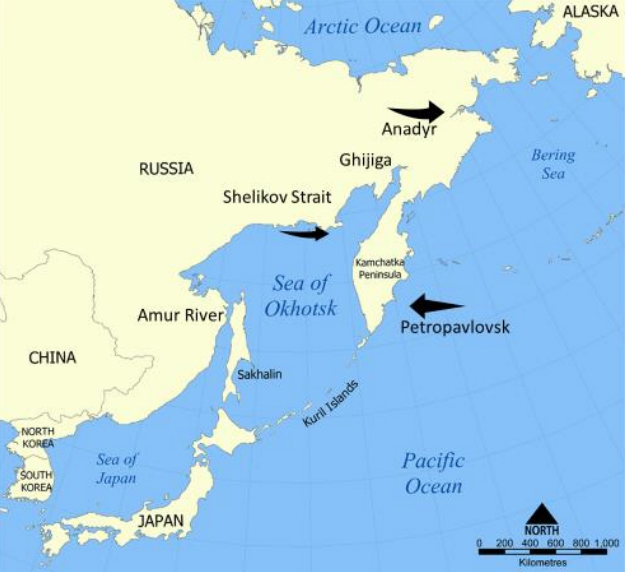
I will focus here on some of the Siberian populations such as the Koryaks and their neighbours that have been identified as genetically the closest related to Indigenous peoples of the New World (Sikora et al. 2019). These peoples have maintained into historic times, at least, some semblance of various forms of hunter-fisher-gatherer societies that utilized dogs.
The current breeds of dogs that are the most likely to have been in the Northeastern portions of Siberia for long periods of time, and not known to be breeds brought from other areas in the last two thousand years, include mostly the Spitz varieties of dogs used primarily as hunting and sled dogs. These include the Siberian Husky, the Samoyed, the Yakutian Laika and the eastern Siberian Laika. By extension and trade relations we also need to consider the genetic ancestors of the Japanese Akita, Ainu, Hokkaido Ken, Kishu-Ken and Shita Inu as well as the Alaska Malamute.
In 1822, Captain John Cochrane observed that “The dogs of Kamschatka may be considered as forming a great part of their Riches .. .employed to transport fish, supply the house with water, the cattle with hay, in short to do all the work that horses perform in England” (Cochran 1824:289).
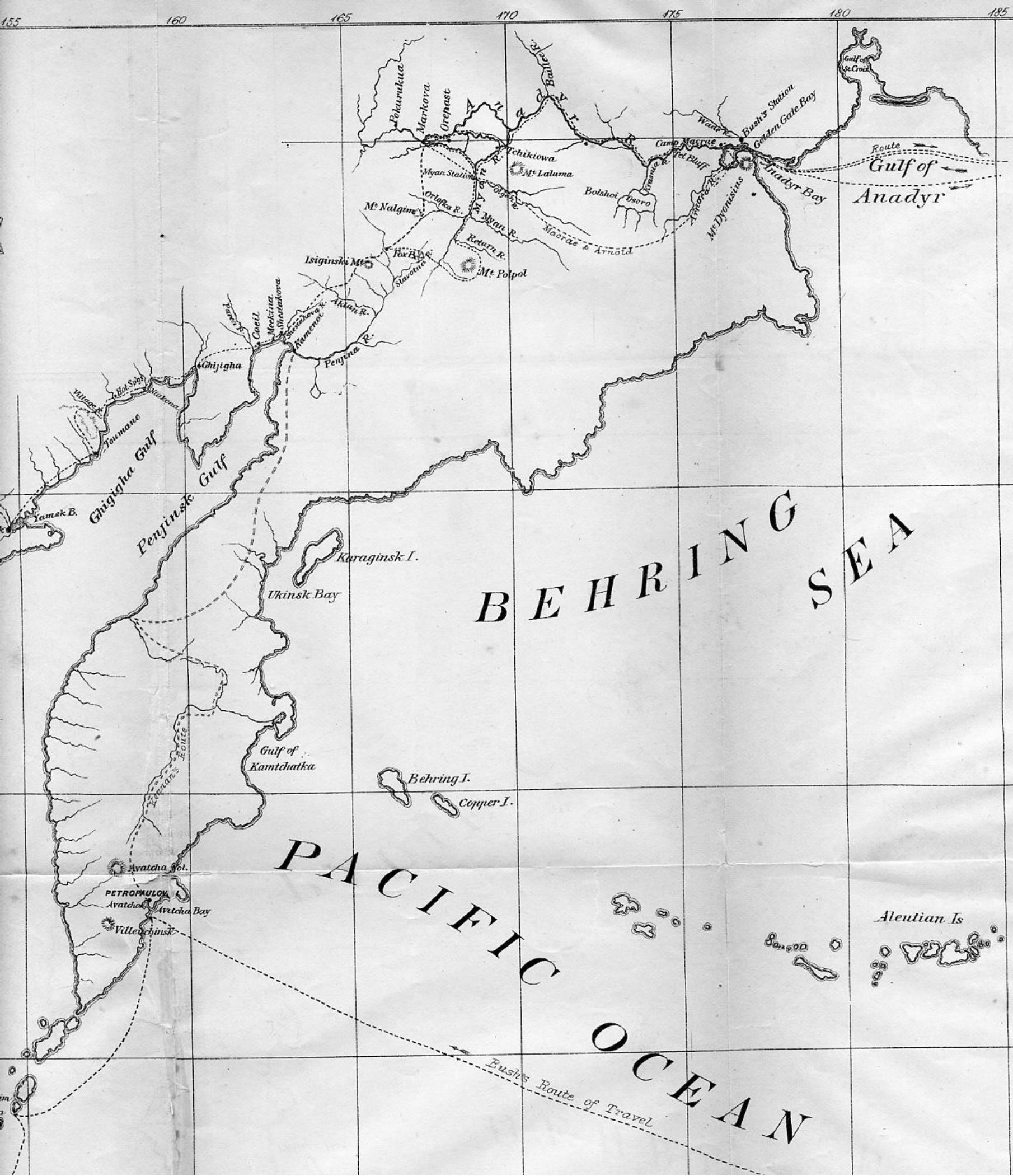
Fishing Dogs and Diet
When Richard Bush visited the Russian district of Okhotsky on the Sea of Okhotsk in 1866, he observed dogs catching their own fish on the Okhota River (Figure 1).
“The dogs constitute a very important feature of the place and are of a fine large breed. In summer they wade into the river and do their own fishing, and rarely fail to procure their regular meal” (Bush 1868:302). At Kamtchatka Bush observed 1000 fish hung up for dogs and noted on the way to Avatcha that each dog was given one fish a day. Again, among the Gilyak on the lower Amur near Marinsk in 1865, he records that Salmon were split and suspended on poles as in Kamtchatka for “the sustenance of both men and dogs during the long winter months” (Bush 1868:52;89-90).
When Thomas Knox visited Okhotsk in 1866, he observed:
“Dogs were more numerous at Okhotsk than at any other place I had visited. They were of all sizes, age, and sexes, and considering our limited acquaintance, they behaved very well. I heard in Kamchatka, that the dogs caught their own fish in summer, but did not have ocular proof of the fact until I reached the Okhota River. As the tide came in the dogs waded out upon the flats and took their stations. After a little miscellaneous watching I fixed my eye on one shaggy beast that appeared to know what he was about. He stood motionless as a statue for some minutes. Suddenly his head disappeared in the twinkling, and there was a slight splash in the water. A moment later the dog walked toward the shore bearing a ten pound salmon in his jaws, and leisurely began his dinner.
That dogs catch and eat fish is not surprising, when it is known that they rarely have other food during the entire year. Fish are fed to them in all forms – boiled. raw, dried, frozen, and putrid – and they eat them with equal aridity, no matter what the mode of serving” (Knox 1868:296).
Much earlier in 1741, Krasheninnikov refers specifically to the dogs of Kamtschatka:
“They are esteemed swifter and longer-lived than any other dogs; and this may be attributed to their light simple food, which is fish. In the spring, every one lets his dogs run at liberty, without taking care about them; for they can be used for travelling only while the snow is on the ground. They then feed upon what they can get in the fields, where they dig for the mice; and in the rivers they, catch fish. In the month of October, the Kamtschadales call them home, and tie them up near their huts, till they lose a good deal of their fat, that they may be lighter for the road. In the winter they are fed with opana and fish-bones, which are laid up for them in summer. The opana … they pour into a large trough, and then throw in some ladlefulls of … rather rotten fish, which is prepared in pits for this purpose, adding to this some fish-bones, and heating the whole with glowing stones until the fish bones be boiled Those which are bred up to hunt the deer and wild rams, sables, foxes, and the like, are sometimes fed with jackdaws, which, it is observed, make their scent the stronger for finding out birds and wild beasts.”.
In other contexts Krasheninnikov notes that the Kamchadal “eat out of the same dish with the dogs” and they do not make cooking fires when travelling “as they and their dogs eat dried fish” (Krasheninnikov 1784).
About 1858 an unidentified British Naval officer said of the sled dogs at Kamchatka in the summer: “subsist principally upon fish, which they catch as easily as an otter does” (Aylmer 1860).
The distribution of fish bones in archaeological sites will vary at different times of the year due to the changing food habits and locations of dogs. When dogs are eating the most fish in the summer time, they are away from the villages sites and leaving their fish containing excrement elsewhere.
Captain John Cochrane notes that dogs “feed as circumstance may dictate, being always left to shift for themselves from June to October” (Cochrane 1824:289).
Langsdorff states the dogs are fed principally on fish given to them as raw or cooked, fresh, frozen, died or putrid. In summer they are left to find their own food along the sea shore and fish in the inland rivers: “When they see a fish they snap at it with such a certain aim, that they rarely miss it: in doing this there whole head is frequently under water. When they can get a superabundance of food, as for instance, at the time when the salmon come up the rivers in shoals, they eat the heads only, as being the finest flavoured part of the fish, leaving the bodies to become putrid. In the autumn these animals are compelled, by a want of food, to return back to their owners in the villages and towns: they are then tied up that they may not be out of the way when wanted to be put to the sledges. At this time they are very fat, so that only a small piece of dried or frozen fish is given them every day, some days even they are not allowed anything, that they may grow lean by degrees, since a very fat dog is heavy, and never draws well.
De Lesseps in 1787, confirms that dogs ate putrified fish and when cutting up fresh fish the entrails were reserved for the dogs, but the Kamchadale themselves fed “voluptuously upon this rotten fish” and like the dogs, they considered the fish heads “the most delicious morsal, and is commonly distributed into many parts” (De Lesseps 1790:90).
In Kamschatka, putrified fish was produced in large pits as it was of parts of the coast of British Columbia. This became used less for dog food after the influence of Russian settlers. Dried or frozen fish became more common as dog food. Langsdorff observed that: “It was very striking to me, that the part of the fish most prised by them when fresh, the head, was, when dried, wholly rejected”. This he attributes to the fact that dried salmon bones become extremely hard and sharp when dried, and the often half famished dogs eat it so quickly they commonly pay for their dinner with a bloody mouth. Langdorff notes that: “Stinking carrion is the most acceptable food they can have; and they will often contend strongly for human excrement.” In order to prevent the dogs from changing the diet to quickly in the summer they are fed fresh fish soup in the spring before they are let to go free Langesdorff (1814).
As a sideline to the Siberian examples I provide here an example of dog food consumption from the Canadian Arctic and northern British Columbia. Elisha Kane on his Arctic expedition commented on August 9, 1853 about the sled dogs on board his ship:
“We have more than fifty dogs on board, the majority of whom might be characterized as ‘ravening wolfs’. To feed this family upon whose strength our progress and success depend, is really a difficult matter to feed them upon the meager allowance of two pounds of raw flesh every other day is an almost impossible necessity.” Two polar bears they obtained for the dogs only lasted eight days (Kane 1875:33-34).
Major P. M. Stewart, while big game hunting in British Columbia, hired two Tahltan guides, named only Peter and Mike, in the Telegraph Creek area. Pete’s dogs seen in a photograph are clearly mixed European breeds and not huskies as he describes them. Pete’s dogs are described:
“These are ‘huskies’ almost as big as St. Bernards, which he had asked my permission to bring with him from Telegraph Creek, as he wanted to get them fattened up on salmon and the game we should kill before the winter, when their duties would begin. They would then draw his sledge or carry packs weighing from 50 to 70lb. One was tawny like a lion and called ‘leader,’ the other was grey like a wolf and called ‘Benny’. Four big dogs draw a sledge carrying 500 lb. weight, and they can do 40 to 50 miles a day”.
Stewart’s Tahltan guide Peter “gaffed 2000 salmon, chiefly Sockeye this season, for his dogs and family during the winter” and “Shot five moose last winter for his dogs and family, and Mike seven”. The picture of these dogs show that they are a large dog of mixed breed and not a Siberian Husky or the later Alaskan Husky.

Descriptions of Dogs
Historic descriptions of Siberian dogs tend to focus on the larger sled dogs, but 19th century commentary and illustrations of adult dogs clearly indicate there were a variety of small dogs. Langsdorff (1814) describes one type with fine wool like hair that can be used for weaving. This could be the predecessor that was bred into the wool dog of southern British Columbia (Keddie 1993).
In 1787. De Lesseps describes the dogs of Kamschatka as “not remarkedly large and resemble pretty exactly our mountain dogs [of France], or such as are commonly used by shepards. There is not an individual habitat, Russian or native, that has less than five” (De Lesseps 1790:116).
Langsdorff (1814) observed two dog types in his nine month stay through the winter of1804-05 on Kamschatka:
“They resemble the wolf very strongly, the European dogs which they most resemble are the Sheppard’s dogs, as they are called, with the pointed noses, the hair of some is straight and short, of others long and soft; a few have the skin covered with a positive wool, of which, if properly washed and prepared, may be spun like the wool of the sheep. The dogs that have this wool, or the long and fine hair, are called magnates, or hairy, and their skins are exceedingly sought after for making warm winter garments, or for trimming the clothes. These kind of dogs are not very good for travelling; they can indeed scarcely be used in fresh fallen snow, or if the snow be very deep, since in either case, it often hangs about the fine hair, and gets entangled with it, where it freezes, and impedes the animal’s running very essentially”
Krasheninnikov (1764), from his 1741 visit, describes the dogs of Kamschatka as of a “middling size, of various colours, though there seem to be more white, black and grey, than any other, In travelling they make use of those that are gelded, and generally yoke four to a sledge.” In another context he refers to the colours as “white, black, spotted white and black, or grey like the wolves”. Langsdoff (1814) also mentions “their colours vary exceedingly; they are black, white, grey, red, and almost all spotted in a great varieties of ways.”.
William Dall, while travelling in Russia on October 25, 1860, makes reference to the dogs of the Tungusic peoples – who he describes as ranging from lake Baikal to Kamchatka and mouth of the Amur River from the arctic shores to the Ohotsk sea and China’s borders:
“The dogs are about the size of those of Newfoundland, with shorter legs, and of all colours, from white, grey, and piebald to black. The sled dogs were usually in teams of five to seven depending on the size of the load” (Dall 1870:25;518).

About 1858, Captain Fenton Aylmer said of the sled dogs at Kamchatka:
“They stand rather over twenty-three inches in height, often twenty-five [5863cm], have a pointed muzzle, pricked ears, and broad, sagacious head; the body is low, and admirably adapted for work and exposure, being protected by long hair, and a thick, warm undergrowth of dun-coloured wool. They seem indigenous to the country, and are found wild among the hills, in which state their habits are identical with those of the wolf, an animal they closely resemble in appearance”. The voice is “something between the howl of a wolf and the bark of a dog, …Trains of dogs vary from seven to eleven and fifteen, and are kept by everyone. They are tied singly, or in pairs, to stakes, in the sledging season” (Aylmer 1860:63-64).
Thomas Knox comments extensively on dogs and shows a lithograph of dogs pulling a boat alongside the Ghijiga River :
“The animals were Kamchadales, and resembled the Esquimaux dogs described by Mr. Kane. They are in general use in Northeastern Siberia during the season of snow, except in a few districts where the reindeer takes their place. Among several tribes of natives, dogs and reindeer are indiscriminately employed, the choice depending upon the nature of the journey, the season when it is undertaken, and the locality to be traversed. For long journeys, in regions where supplies are scarce, reindeer are better than dogs. They search for food under the snow, and can generally find moss enough for their support. Provisions for dogs must be carried by the traveler, except where it can be found at the villages on the route. For a long journey the weight of dog food will seriously diminish the carrying capacity of the team.” – “The Kamchadale dogs do not bark, but they can howl most unmelodiously.”
The dogs are fed at sunset. “Five dogs make a good team for a light sledge carrying a single person with his baggage. With good roads such a team can make fifty miles daily for a week or more, and can go a hundred miles without resting if an emergency demands it. .. .The natives in the district of Ghijiga comprise the Koriaks and Chukchees, the former keeping both reindeer and dogs and the latter only reindeer.” (Knox 1868:294).
John Bell, a British physician, traveled to Siberia in 1729, was an astute observer based on his dispatches to the St. Petersburg Academia of Science. He observed, that when the environmental conditions were right for sledding, they procured dogs that were: “yoked by pairs; and are more or fewer, in number, according to the weight they have to drag, .The dogs are fastened to the sledge by a soft rope, which is tied around their middle, and passes through between their hind legs” (Bell 1966:70-71).
Bush shows a lithograph of the dog teams he took travelling east from the Uda River (1871:186-7) and describes them as being “like those we had seen in Kamtchatka, and a more ravenous, wolfish pack I never beheld fed once a day at night” (Bush 1871:181-3).
George Kennan landed on August 20th, 1865 at the south end of Kamtschatka at the important Russian settlement of Petropavlovski where he observed “the wooden frames every-where filled with thousands of drying fish, and the howling of two or three hundred half wild dogs”. By October 1, he had travelled on land 500 miles north heading for the Russian settlement of Ghijiga, at the head of Shelikov Strait in the Okhotsk sea. In making their last effort to reach Ghijiga they collected “from all the surrounding settlements, about 200 dogs, which we divided into sixteen teams, and providing ourselves with forty days’ provisions”.
Kennan noted at this time, in speaking of the southern Kamchadals, that they: “have almost entirely lost their distinct nationality by intercourse and intermarriage with the Russians. They have adopted the Russian language and religion, live in log-houses instead of tents and cultivate the soil, all of which things are directly contrary to the taste and feeling of every true Siberian native. — Sable trapping, fishing and the cultivation of rye and potatoes, are the occupations of nearly all the Kamchadals, who are settled in little log villages throughout the peninsula, on all the rivers which fall into the Okhotsk sea or the Pacific”.
The more northern Koryaks he notes are different and “compose one of the largest of the Siberian and Kamtschatkan tribes, are essentially a wandering people.
Living in skin tents, and owning herds of from I,000 to I2,000 reindeer, they move from place to place with the greatest facility, —That portion of the tribe which wanders in Kamtschatka is divided into forty or fifty different bands, composed of six or eight families each having and owning an average number of 3,000 reindeer to each band”.
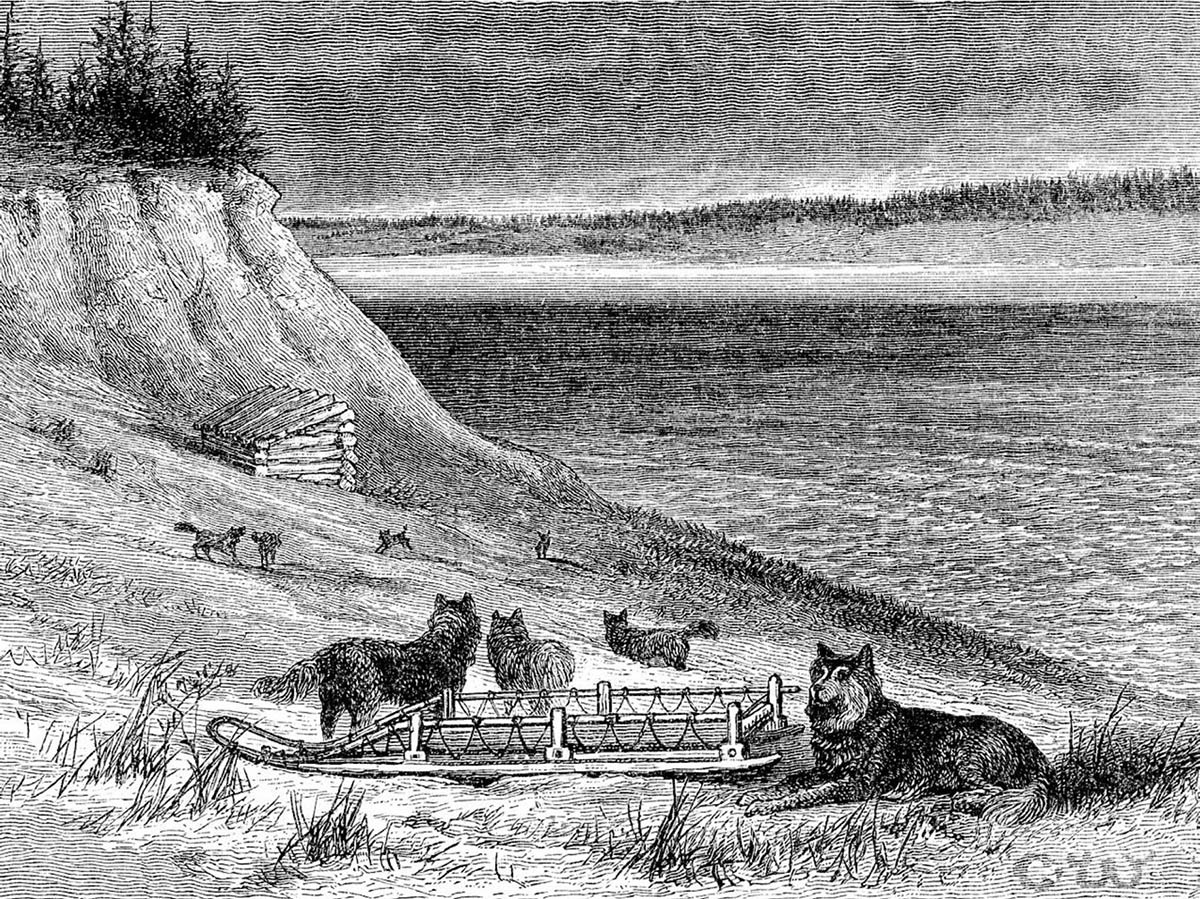
Fifteen years later, Henry Seebolm was travelling in western Siberia, the 723 miles from station to station, from Turkhansk to Yenisei . He was using horse travel but describes the dog teams he came across:
“As we go further north we found fine dogs at the stations, and occasionally we met a sledge drawn by dogs. These animals are most sagacious. A Russian traveler will hire a sledge with a team of six dogs, travel in it ten or fifteen miles to the next station, where he gives the dogs a feed, and sends them home again alone with the empty sledge. On several occasions we met empty sledges returning alone with the team of dogs. They are fine fellows, a little like a Scotch Shephard dog, but with very bushy tail. They have very sharp noses. Short straight ears, and a bushy tail curled over the back. Some are black. Others white, but the handsomest variety is a grey-fawn colour” (Seebohm 1882:43).
Kane refers to the quality of his dogs used in the Canadian Arctic on September 13, 1853: “My dogs were both Esquimaux and Newfoundlanders. Of the last I had ten. Six of them made a powerful travelling team, The Esquimaux dogs were reserved for the great tug of the actual journeys of search. …A hard experience had not then opened my eyes to the inestimable value of these dogs. I had yet to learn their power and speed, their patient, enduring fortitude, their sagacity in tracking these icy morasses, among which they had been born and bred”. The Inuit dogs were reserved for the longer journeys – “making the Newfoundland dogs establish the depots within sixty miles of the brig.” (Kane 1875: 65).
Indigenous dogs began disappearing with the changing economy due to outside cultural influences and especially the introduction of the gun. Owen Lattimore observed the influence of the Chinese in 1930 among the Gold people of the lower Amur River: “Of the true Gold breed of dog there are now unhappily very few left. In appearance it is obviously similar to the Arctic ‘hustky’ breeds, at once distinguishable from the Chinese or Mongul type. The same breed was used for hunting and for work with sleds. The few survivors are used for hunting only; but hunting is done chiefly without dogs” (Lattimore 1933).
Dogs and the Creation of Humans
Krasheninnikov records an account in 1755 of Koriaks on Karaginsk island across from Cape Koutu that the other Koriaks did not recognize as part of their tribe. “They are called Khamsharen, ‘descendents of dogs’, because according to their tales, Kut at first created only dogs in this place, who were then metamorphosed into men. These island people live so much like animals, and their way of Living is so disgusting, that they can be forgiven this fable; for the customs of these islanders seem as barbarous and wild to the Koriaks as their own customs appear to civilized nations” (Vaughan 1970).
Religion and the Sacrifice of Dogs
The cultural anthropologist Maria Czaplicka, specialized in Siberian shamanism and centered her ideas around the connection between religion and environment in Siberia. In her field work in Siberia she recorded the existence of a thusind ritual which was an alternative to blood revenge. This right to compensation in a dispute within the Gilyak clans involved an arbitrator from another clan. Two dogs were sacrificed at the end of the resolution. The dogs were offered as a sacrifice to the bird avenger. The murdered person appears in the form of a bird. A feast is then held and the thusind paid (Czaplicka 1914:48-49).
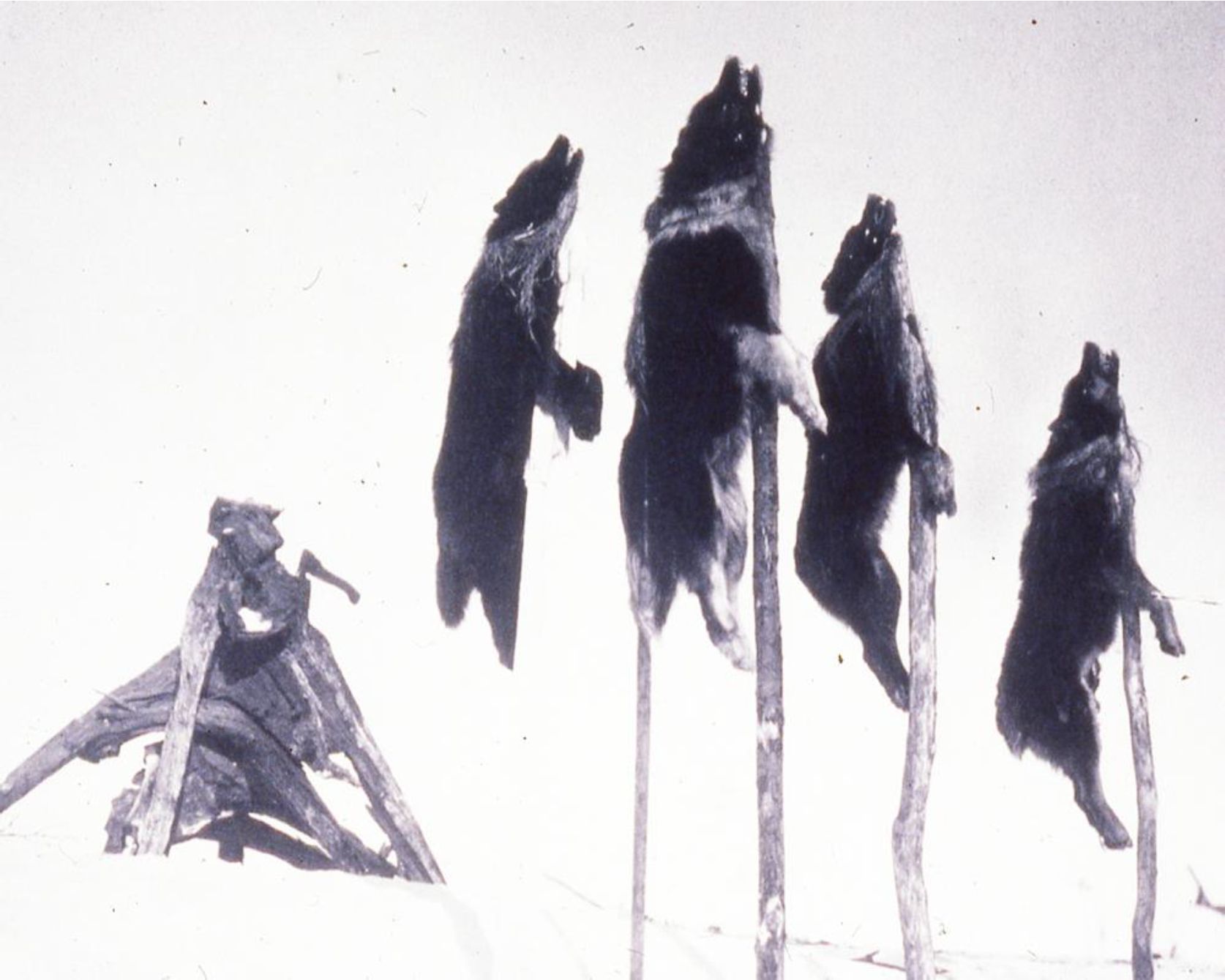
In 1901, Waldamar Jochelson leaned about the extremes of dog sacrifice after he rented twenty dog sledges from the Paren Koryaks to travel through their territory. After the Peren returned home Jochelson returned to their village and was: “surprized at the number of dog sacrifices that were hanging there. All along the bank of the Paren River were stakes driven into the snow. with dogs hanging from them, their muzzels pointing upward I found out that the greater part of the dogs had been killed by the drivers of the sledges which I had hired in gratitude for their safe return from Gizhiginsk, and to guard their villages against the spirit of measles, which a year previously had come to them from that little town” (Jochelson 1905).
Kennen also notes dog sacrifice in times of calamity when the Koryak consult their shamans or priests: “The priest, to whom application is made, assembles the band in one of the largest tents, puts on a long robe stamped with figures of birds and beasts, and curious hieroglyphic emblems, unbinds his long black hair, and taking up a baraban or native drum, begins to sing a low monotonous chant to the accompaniment of slow, steady drum-beats. As the song progresses it increases in energy and rapidity, the priest contorts his body into the most unnatural shapes, rolls his eyes wildly in his head and seems to go into a frenzied trance. Finally, he springs to his feet, and jerking his head convulsively until his long hair fairly snaps, he begins a frantic dance about the tent. In a few moments he sinks apparently exhausted into his seat, and delivers to the awe stricken natives the message which he has received —which generally consists of an order to sacrifice a certain number of dogs or reindeer” (Kennen 1876).
Physical anthropologist Jerome Cybulski observed human burial related food offerings and “one or two possibly two instances in the form of dog skulls” at the Greenville site on the north coast of British Columbia (Cybulski 1992:67-73).
Among the Gilyak: “The dead man’s favourite dog is placed next to him for a time, and will receive and keep for a few months a portion of his masters soul. During this time the dog lies in the sleeping place and receives the best food; this ceases when the portion of the soul returns with all the other souls to its master in Mly-vo [the habitation of the dead]” (Czaplicka 1914:152).
Richard Bush had noted in 1866, that Gilyak dogs were sacrificed at funerals and at death it was believed that one’s spirit goes into one’s favorite dog (Bush 1868:102). Bush observed dog sacrifices among the Koryak that resulted when they were threatened by sickness or disaster. In the village of Coeil he saw on a house pole several dead dogs “suspended as sacrifices”. He observed dog foodsuspended in under part of houses and in the upper part of house “several little pups choked to death with wisps of straw, the latter also as sacrifices to their pagan gods.” (Bush 1868:351; 356).
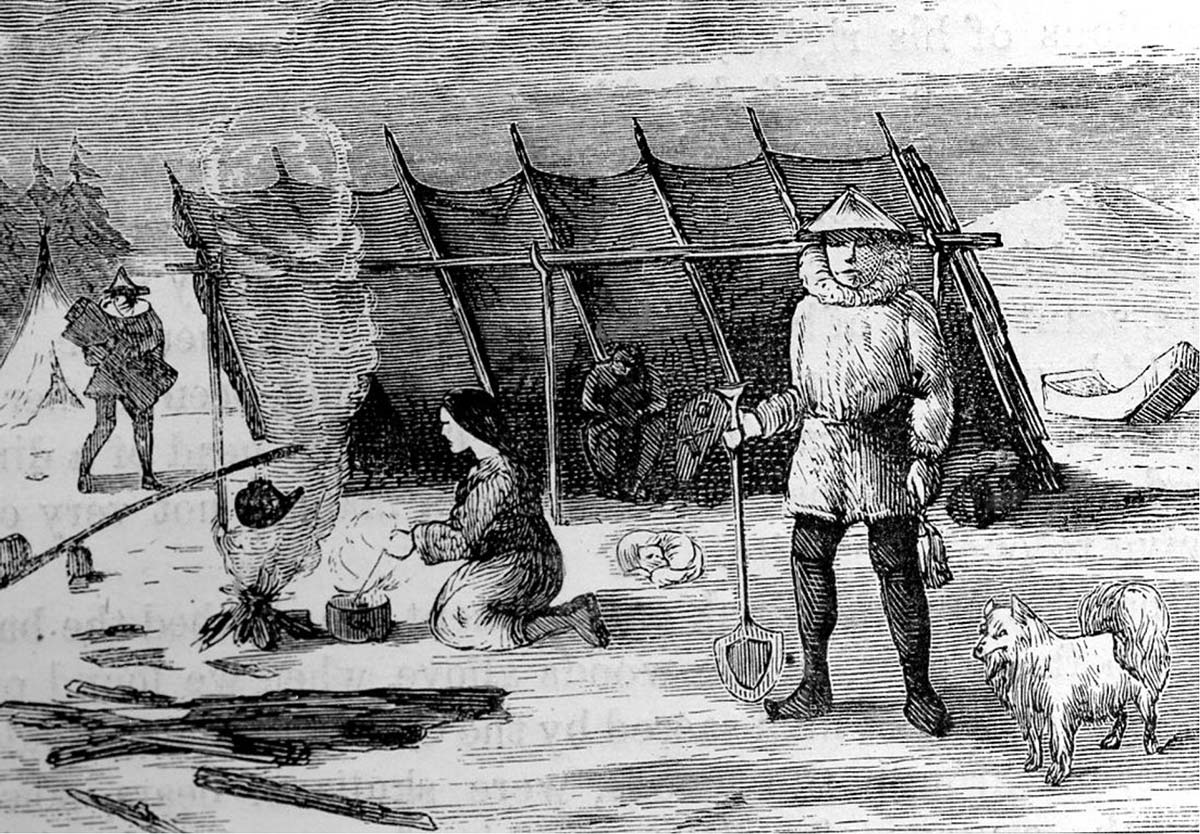
Chernetsov observed in 1720, that special care was taken when a dog died among the Verkhotur Mansi. The dead dog was placed in a little wooden house on posts. When the house collapsed they buried the dog in the ground (Chernetsov 1963:40).
Among the Chukchi, Czaplicka stated:
“At the entrance to this underworld are found dogs as guardians, and a person who used to beat his dog during his life on earth will be stopped by them” and “a dead person has to traverse difficult paths before reaching the other world; he also has to pass through the country of dogs, and a man who has ill-treated these animals will be severely injured by them.” (Czaplicka 148; 150).
The Use and Trade of Dog Fur and Skins
De Lessep shows a seasonal use of some dog skins. Men and women wore boots “in summer, of goats or dog skins tanned; and in winter, of skins of sea wolves [sea lions]or the legs of deer: (De Lessep 1790).
Krasheninnikov noted that the dogs of Okosk: “serve instead of sheep, because their skins are used for clothes; particularly those of the white dogs, with which all their different sorts of garments are trimmed”. The Kamschatka trade with a western branch of the Koryak, involved “white dog skins” for reindeer skins (Krasheninnikov 1764). Among the Nivkh story of about a man named Azmun the people wore coasts of black dog fur (Nagishkin 1980). Mention is made by Bogoras, from his observations in 1901, that the sea mammal hunting Koryak “have but few dogs” and do not go far from their coastal villages (Bogoras 1917).
A specific use of white dog skins is noted by Sem who indicates that the Turkish speaking Dolgan of western Siberia hunted deer “while camouflaged in white dog skin parkas” (Sem 1997).
Krasheninnikov said that the people of the Kurile Islands north of Japan “placed a higher value on dog skins than of sea otters. In the 1740s they would willingly exchange a dress made of sea otter for a good one made of dogs’ skin, which they considered to be warmer, and a better defense against the water” (Krasheninnikov 1764). In 1871, Bush noted that dog fur was used as a trim for hoods and for socks (Bush 1871:60-61).
In a Nivkh story from the Amur River Dmitri Nagishkin recorded the story of The Brave Azmun, where “They wore the coats of black dog fur” (Nagishkin 1980).
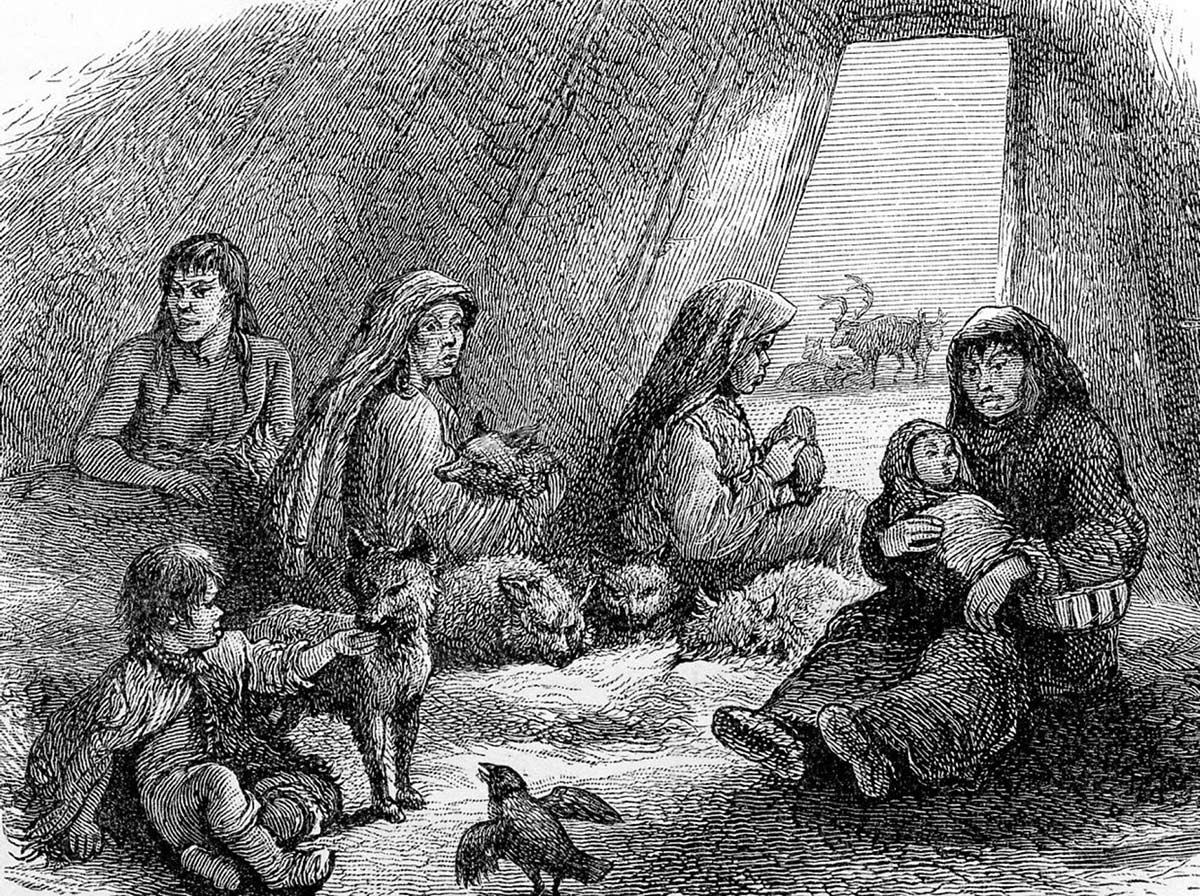
Training of Dogs
Langesdorff (1814) provides the most comprehensive notes on dog training for sled use. Younger dogs are “fed with a soup made of fish, of which they are allowed to eat as often and as much as they please, so that they sometimes fill themselves to such a degree that they can scarcely stir, and their belly seems ready to burst; this soup should be given them milkwarm, never hot”.
All sled dogs undergo castration when they are between five and six months old. Uncastrated dogs and females kept for breeding are not used as sled dogs except in emergencies when there is a shortage of dogs. Sled dogs have their tails docked when they reach their full growth between the ages of two to three. Langsdorff observed that few Kamschatka dogs were seen that were not docked, but this is generally not mentioned by other authors and dogs with docked tails are usually not drawn by artists. Langsdorff indicates that the tall legged and thinly haired dogs are the beat for drawing a light sledge. The younger dogs are first trained with lighter loads over shorter distances. Every dog is given a name when it is young which is commonly taken from some physical appearance such as short-ear, long ears, hanging ears, sharp nose, red spot, black head, white foot or short tail. The sled dogs are steered and sped up by calling out the individual names of the dogs, rather that using a whip (Langsdorff 1814).
Care and Diseases of Dogs
In July of 1866, at Avatcha Bay, Bush indicated that the human population of Petropavlovsk, the capital of Kamchatka, was about four hundred with “fifteen hundred dogs. Most of the four-footed inhabitants were at their summer residences in the country, only a hundred or more of them remaining in town.”
In this region it was absolutely necessary for dog teams to go to the interior lakes and bring back fish for the winter food supply. This became a crisis in the event of a shortage of snow for dog team travel or a shortage of fish which required travel to neighbouring tribes in search of food.
Famines occurred every three or four years. Often the last of the food was shared with dogs in order for them to help get food to keep the people alive. There were distemper outbreaks “every two or three years among the dogs of these regions, and almost invariably proves fatal; sometimes hundreds of them are swept off in a single week. At such times money cannot purchase the survivors”. At Anadyr, four fifths of all the dogs died from distemper. There were no fish and people were starving (Kennen 1876).
Elisha Kane had over fifty dogs which included Inuit dogs and ten Newfoundland dogs that he took to northern Canada. On January 21, 1854 he noted that most of them died after the attack of a “brain disease”. It is most likely that this was distemper caused by a paramyxovirus and spread by having the dogs in close quarters on the ship. (Kane 1875).
Dogs were sometimes beaten. Kennen observed in 1865, that after their dog teams came suddenly upon a Koryak settlement “our wolfish dogs, crazy with excitement, dashed down at a gallop upon the vast herd of reindeer which stood still and peaceful around the black tents. The dogs, however, were finally stopped and beaten into submission.”
The dogs of the Gilyak on the lower Amur River were observed in 1865 in a temporary shelter of birch bark over poles:
“a dozen humans and about as many dogs lay twisted and coiled into almost every conceivable shape” including “an old half-famished, toothless dog”. Bush also observed fur socks were made for dogs to use in icy conditions as we know was done in Alaska and British Columbia (Bush 1871:124; 322; 453).
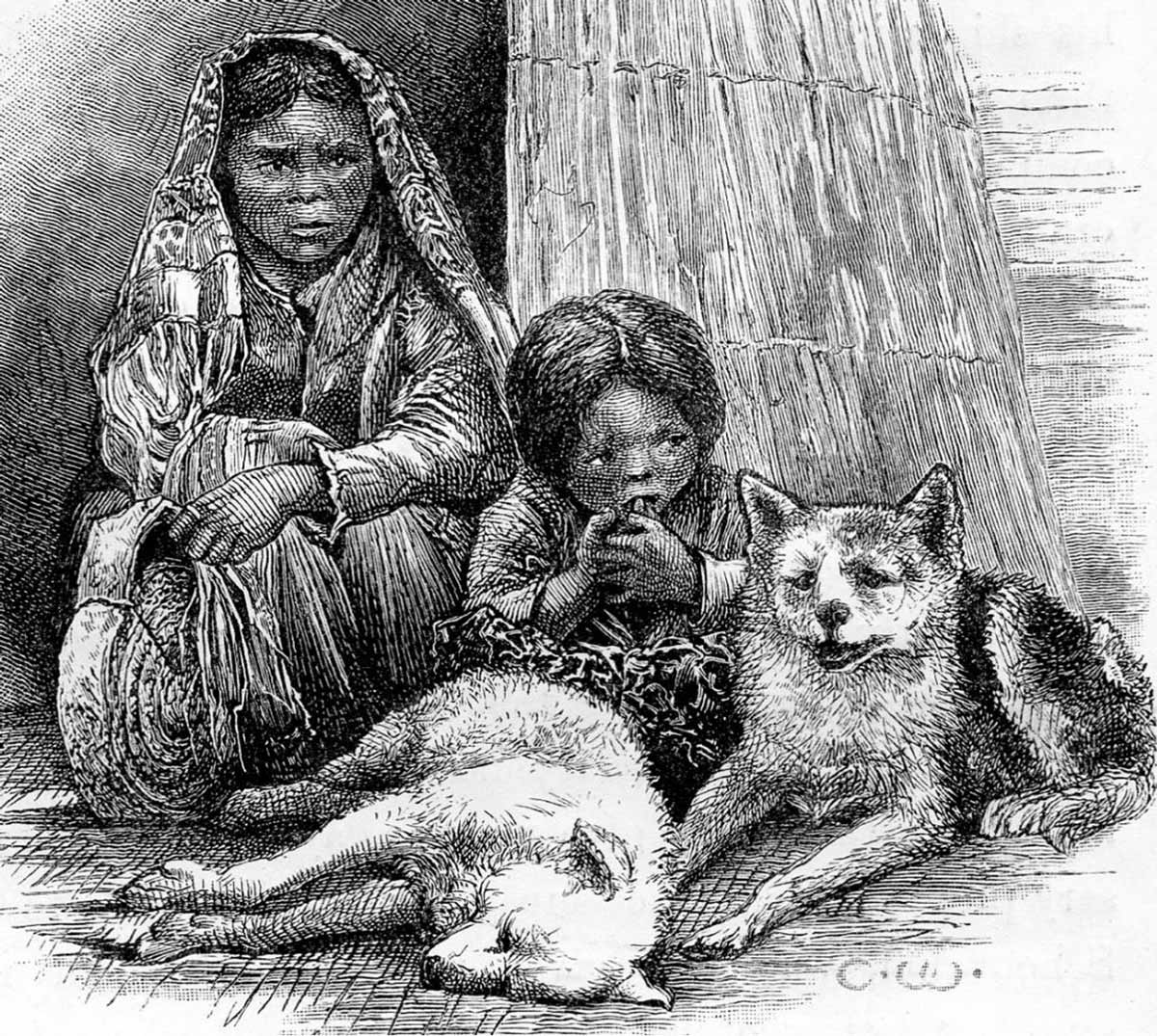
Summary
We know from historic documentation and DNA analysis that there has been a stream of new human immigrants into Siberia. The most extensive changes being the movement of Turkish speaking peoples starting in the 8th century A.D. and Russians beginning in the 16th century (Dmytryshyn et. al. 1985 and 1988; Gibson 1969).
These movements resulted in the displacing and blending with older human populations and would have also resulted in new dog breeds being brought into Siberia from outside. We could expect periods of blending and isolation in dog populations that would vary from region to region. However, given the adaptability of indigenous breeds these would likely have been maintained in those areas where they were essential to human survival even with human population displacement.
Dogs were used as pulling sleds on Zhokhov Island in the East Siberian Sea by at least 9000 years ago and likely much earlier (Pitulko and Kasparov 2017). Domestic dogs identified by the main DNA haplogroup A2 have been in Siberia for at least around 20,000 years ago. We know they were in Kamchatka by 13,000 years ago and their descendants came into the New World with the earliest human population movements. Others, referred to as the Lake Baikal linages, likely came from the south coast of Siberia in later times (Bergstrom et. al. 2020). Dog skulls from the Iron age Ivolginsk Fortress were identified as being most like the East Siberian Laika dogs. This suggests that this northern type of dog were relatively widespread during most of the Holocene in the Baikal and Amur regions (Sizova et. al. 2021). Intensive breeding programs during the Russian fur trade may have favoured the production of more dogs with the appearance of the modern-day Siberia husky at the expense of a greater diversity of dogs.
Dog numbers varied over time and were more prevalent where they contributed to the economy in terms of transportation and hunting as well as in some cases in providing fur for clothing. Dogs were likely selected and bred for their sledding and hunting skills, but also for colour patterns, such as the case where white fur was of a higher value.
Small varieties of dogs that could form, at least in part, the genetic make-up of the ancestral Wool dogs of the southern coast of British Columbia were found in Kamschatka and the lower Amur River regions (figures 8 and 12). The wool dogs of southern British Columbia were not all white. Some were described as brown or brownish black (Keddie 1993).
Further studies of ancient dogs in British Columbia will likely provide some interesting features of dog and human interactions. What we know about historic dog behavior in Siberia may help broaden our thinking about this complex subject.
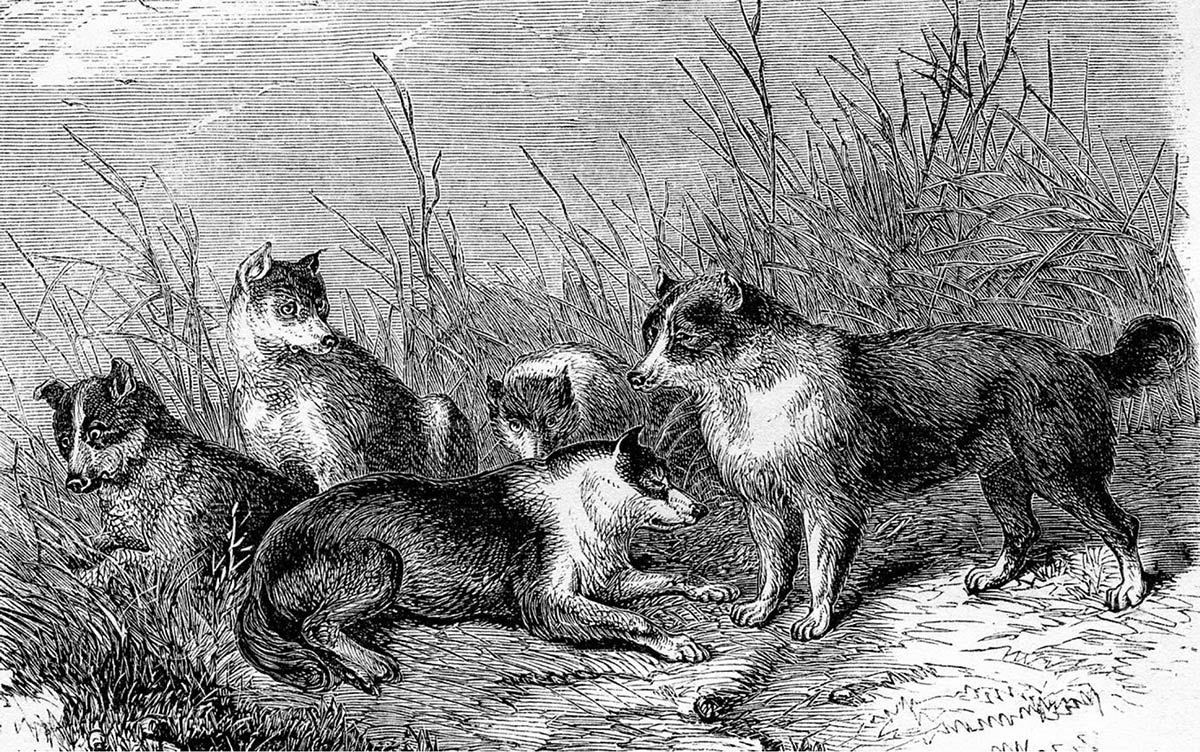
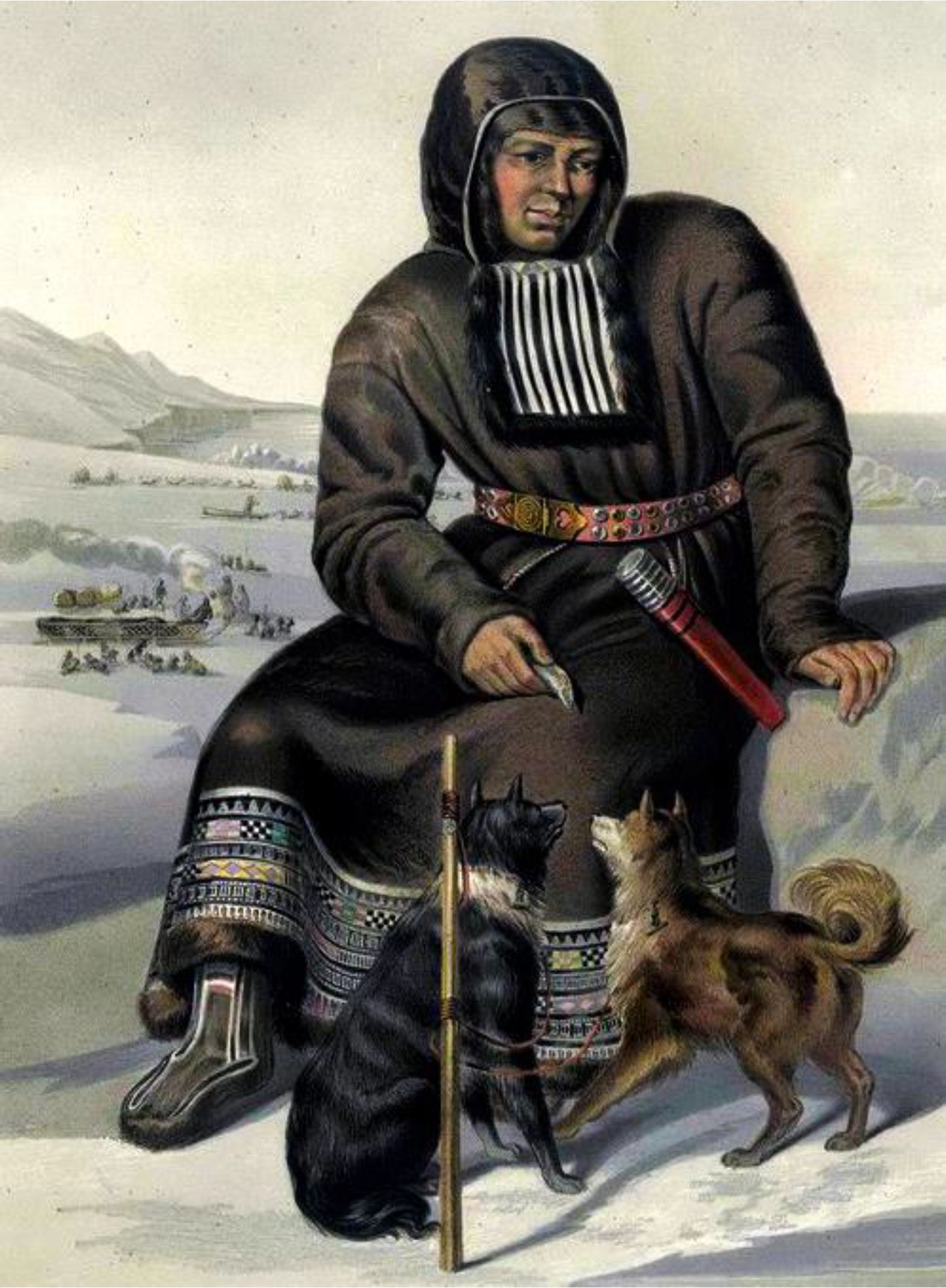
References
Atkinson, Thomas Witlam. 1882. Travels in the Regions of the Upper and Lower Amoor and The Russian Acquisitions in the Confines of India and China. With Adventures Among the Mountain Kirghis, and the Manjours. Manyargs, Toungous, Touzmts, Goldi, and Geltaks: The Hunting and Pastoral Tribes. Harper Brother Publishers, New York & St. Petersburgh.
Albizura, Silva, Aurora Grandal-d’Anglade, Julia Maroto, Monica Oliva, Alba Rodriguez, Noemi Terrats, Antoni Palomo & F. Javier Lopez-Cachero. 2021. Dogs that Ate Plants: Changes in the Canine Diet During the Late Bronze Age and the First Iron Age in the Northeast Iberian Peninsula. Journal of World Archaeology, 34:75-119.
Ameen, Carly. Tatiana R. Feuerborn, Sarah Brown, Anna Linderholm, Arden Hulme-Beaman, Ophelle Lebrasseur, Mikkel-Holger S. Sinding, Zachary T. Lounsberry, Audrey T. Lin, Martin Appelt, Lutz Bachmann, Matthew Betts, Kate Britton, John Darwent, Rune Dietz, Merete Fredholm, Shyam Gopalakrishnan, Olga I Gorlunova, Bjarne Gronnow, James Halle, Jon Hallstein Hallsson, Ramon Harrison, Mads Peter Helde-Jorgensen, Rick Knecht, Robert J. Losey, Edouard Masson-MacLean, Thomas H. McGovern, Ellen McManus Fry, Morten Meldgaard, Aslauf Midtdal, Madonna L. Moss, Luril G. Nikitin, Tatiana Nomokonova, Albina Hulda Palsdottir, Angela Perri, Aleksandr N. Popov, Lisa Rankin, Joshua D.Reuther, Mikhail Sablin, Anne Lisbeth Schmidt, Scott Shirar, Konrad Smlarowshki, Christian Sonne, Mary C. Stiner, Mitya Vasyukov, Catherine F. West, Gro Birgit Ween, Sanne Eline Wennerberg, Oystein Wiig, James Woolett. Love Dalen, Anders J. Hansen, M. Thomas P. Glbert, Benjamin N. Sacks, Laurent Frantz, Greger Larson, Keith Dobne, Christyann M. Darwent and Allowen Evin. 2019. Specialized sledge dogs accompanied Inuit dispersal across the North American Artic. Proceeding of the Royal Society B 286:20191920.
Ames, K. M., M.P. Richards, C.F. Speller, . D. Y. Yang, R. L. Lyman, and VL. Butler. 2015. Stable Isotope and ancient DNA analysis of dog remains from Cathlapotle (45CL1), a contact-era site on the lower Columbia River. Journal of Archaeological Science, 57:268-282
Asch, Barbara, Ai-bing Zhang, Mattias C.R. Oskarsson, Cornelya R.C. Klutsch, Antonio Amorim and Peter Savolainen. 2013. Pre-Columbian origins of Native American dog breeds, with only limited replacement by European dogs, confirmed by mtDNA analysis. Proceedings of the Royal Society. 280:2013.1142.
Aylmer, Captain Fenton (Editor). 1860. Cruise in the Pacific. From the Log of A Naval Officer. Vol. II. Literary Gazette, Hurst and Blacket, London.
Bell, John Lorenz Lange. 1966. Travels from St. Petersburgh in Russia, to Various Parts of Asia. Vol. 1. 1788, Edinburgh. New edition. 1966. Edinburgh.
Bergstrom, Andres; Lauren Frantz; Ryan Schmidt; Erik Ersmark et. al. 2020. Origins and genetic legacy of prehistoric dogs. Science 370:6515:557-564
Boas, Franz 1889. First General Report on the Indians of British Columbia. British Association for the Advancement of Science. Report on the North-Western Tribes of Canada.
Bogoras, Waldemar. 1917. Koryak Tests. Volume V. Publications of the American Ethnological Society. Edited by Franz Boas. E.J. Brill, Limiited, Leydan.
Bush, Richard. 1871. Reindeer, Dogs, and Snow-Shoes: A Journal of Siberian Travel and Explorations Made in the Years 1865, 1866, and 1867; Harper & Row Publishers, New York.
Chernetsov, V.N. 1963. CONCEPTS OF THE SOUL AMONG THE OB UGRIANS. In: Studies in Siberian Shamanism No. 4, (ed) Henry N. Michael. University of Toronto Press, pp. 3-45.
Coelho FA, Gill S, Tomlin CM, Heaton TH, Lindqvist C. 2021. An early dog from southeast Alaska supports a coastal route for the first dog migration into the Americas. Proceedings of Biological Science. Feb 24;288 (1945)
Cochrane, Capt. John Dundas, RN. 1824. Narrarive of a Pedestrian Journey through Russia and Siberia Tartary, from the Frontiers of China to the Frozen Sea of Kamtchatka; Perfprmed during the years 1820, 1821, 1822, and 1823, Philadelphia.
Crockford, Susan J. 2000. Dogs Through Time: An Archaeological Perspective. In: Proceedings of the 1st ICAZ Symposium on the History of the Domestic Dog. (B.A.R.). Vol S889. Archaeopress, British Archaeological Reports, Oxford.
Crockford, Susan J., and Kuzmin, Yaroslav V., 2012. Comments on Germonpre et al., Journal of Archaeological Science 36, 2009 “Fossil dogs and wolves from Palaeolithic sites in Belgium, the Ukraine and Russia: osteometry, ancient DNA and stable isotopes”, and Germonpre, Lazkikova-Galetova, and Sablin, Journal of Archaeological Science 39, 2012 Palaeolithic dog skulls at the Gravettian Pedmostf site, the Czech Republic. Journal of Archaeological Science 39(8), 2797-2801.
Crownhart-Vaughan. 1970. A translation of Stepan Petrovich Krasheninnikov’s Opisanie zemli Kamchatki (1755) (The description of the land of Kamchatka). Master of Arts Thesis. Portland State University.
Cybulski, Jerome S. 1992. A Greenville Burial Ground: Human Remains and Mortuary Elements in British Columbia Coast Prehistory. Archaeological Survey of Canada Paper Mercury Series Paper 146, Canadian Museum of Civilization, Gatineau.
Czaplicka, Maria Antonina. 1914. Aboriginal Siberia. A Study in Social Anthropology, Clarendon Press, Oxford.
Dall, William H. 1870. Alaska and It’s Resources. Boston: Lee and Shepard.
De Lesseps, M. 1790. Travels in Kamschatka, During the years 1787 and 1788. Vol. 1.
Dmytryshyn, Basil, E.A.P. Crownhart-Vaughan, and Thomas Vaughan (editors and translators). 1985. Russia’s Conquest of Siberia, To Siberia and Russian America. Three Centuries of Russian Eastern Expansion 1558-1700. Volume One. Oregon Historical Society Press, Eugene.
Dmytryshyn, Basil, E.A.P. Crownhart-Vaughan, and Thomas Vaughan (editors and translators). 1988. Russian Penetration of the North Pacific Ocean. To Siberia and Russian America. Three Centuries of Russian Eastern Expansion 1700-1797. Volume Two. A Documentary Record. Oregon Historical Society Press, Eugene.
Fedje, Daryl, Quentin Mackie, Duncan McLaren, Becky Wigen, John Southon. 2021. Quaternary Science Reviews. 272 (107221):1-24.
Feuerborn, Tatiana, Alberto Carmagnini, Robert J. Losey, Lorantz Fran et. al. 2021. Modern Siberian dog ancestry was shaped by several thousand years of Eurasian-wide trade and human dispersal. Proceedings of the National Academy of Sciences, 118 (39).
Germonpre, Mietje, Sergey Fedorov, Petr Danilov, Patrik Galeta, Elodie-Laure Jimenez, Mikhail Sablin, Robert J. Losey. 2017. Palaeolithic and prehistoric dogs and Pleistocene wolves from Yakutia: Identification of isolated skulls. Journal of Archaeological Science 78:1-19.
Gibson, James R. 1969. Feeding the Russian Fur Trade. Provisionment of the Okhotsk Seaboard and the Kamchatka Peninsula 1639-1856. The University of Wisconsin Press, Madison, Milwaukee, and London.
Harris, Alison J.T. ; Deirdre A. Elliott, Eric J. Guiryd; Matthew Van Tersch, Lisa Rankin, Peter Whiteridge, Michelle Alexander, Gunilla Erikssona and Vaughan Grimes. 2020. Diversity in Labrador Inuit sled dog diets: Insights from 513C and 515N analysis of dog bone and dentine collagen. Journal of Archaeological Science: Reports, vol. 32:102424.
Hillis, Dylan. Iain McKechnie, Eric Guiry, Denis E. St. Claire & Chris T. Darimont. 2020. Ancient dog diets on the Pacific Northwest Coast: zooarchaeological and stable isotope modelling evidence from Tseshaht territory and beyond. Scientific Reports volume 10, number: 15630.
Jochelson, Waldemar. 1905. The Koryak, American Museum of Natural History Memoir, Part 1-2, Publications of the Jesup North Pacific Expedition.New York.
Kane, Elisha Kent. 1875. Arctic Explorations in Search of Sir John Franklin. T. Nelson and Sons, Edinburgh.
Keddie, Grant. 1993. Prehistoric Dogs of B.C. Wolves in Sheeps’ Clothing? The Midden. Publication of the Archaeological Society of British Columbia, 25 (1):3-5.
Krause, Aurel. 1956. The Tlingit Indians. Results of Trip to the Northwest Coast of America and the Bering Sea. Translated by Erna Gunther. University of Washington Press, Seattle.
Kennen, George. 1876. A Dog-Sledge Journey in Kamtschatka and North-Eastern Siberia. Journal of the American Geographical Society of New York, 1876 (8): 96130. Digitized by Taylor & Francis, Ltd.
Knox, Thomas W. 1868. To And Upon The Amoor River. Harper’s New Monthly Magazine, 37(569)289-306, August, New York.
Krasheninnikov, Stepan Petrovich. 1764, The History of Kamschatka and the Kurilski Islands with the Countries Adjacent. Translated by James Grieve, M.D., T. Jeffweya, Geographer to his Majesty, London. Reprinted by Quadrangle Books, Inc, Chicago, 1982.
Krasheninnikov, Stepan Petrovich, 1970. A translation of Stepan Petrovich Krasheninnikov’s Opisanie zemli Kamchatki (The description of the land of Kamchatka) by E.A.P. Crownhart Vaughan” (1970). Dissertations and Theses. Portland State University.
Langsdorff, George H. Von 1813-14. Voyages and Travels in various parts of the World, during the years 1803, 1804, 1805, 1806 and 1807. London, 1813-14. Volume II. Reprinted as Bibliotheca Australiana #41, N. Israel/Amsterdam, 1968.
Lattimore, Owen. 1933, The Gold Tribe, “Fish Skin Tartars: of the Lower Sungari. Memiors of the American Anthropological Association. No. 40.
Leathlobhair Ni M, Perri AR, Irving-Pease EK, Witt KE, Linderholm A, Haile J, Lebrasseur O, Ameen C, Blick J, Boyko AR, Brace S, Cortes YN, Crockford SJ, Devault A, Dimopoulos EA, Eldridge M, Enk J, Gopalakrishnan S, Gori K, Grimes V, Guiry E, Hansen AJ, Hulme-Beaman A, Johnson J, Kitchen A, Kasparov AK, Kwon YM, Nikolskiy PA, Lope CP, Manin A, Martin T, Meyer M, Myers KN, Omura M, Rouillard JM, Pavlova EY, Sciulli P, Sinding MS, Strakova A, Ivanova VV, Widga C, Willerslev E, Pitulko VV, Barnes I, Gilbert MTP, Dobney KM, Malhi RS, Murchison EP, Larson G, Frantz LAF. 2018. The evolutionary history of dogs in the Americas. Science. No. 361:81-85.
Lee, Esther J, Andrew D. Merriwether D. Andrew, Alexei K, Kasparov, Pavel A. Nikolskiy, Marina V. Sotnikova, Elena Yu Pavlova, Vladimir V. Pitulko. 2015. Ancient DNA Analysis of the Oldest Canid Species from the Siberian Arctic and Genetic Contribution to the Domestic Dog. PLoS ONE 10(5):e0125759.
Loftus, John P., Molly Yazwinski, Justin G. Milizio, and Joseph J. Wakshlag. Energy requirements for racing endurance sled dogs. Journal of Nutritional Science. 2014:3:34.
Losey, R.J., R.P. Wishart, J.P.L Loovers (Eds.), 2018. Dogs in the North: Stories of Cooperation and Co-domestication, Routledge, pp. 61-86.
Losey, Robert J.; Olga Bachura; Tatiana Nomokonova; Mokhall Sabin. 2018. Dogs were domesticated in the Arctic: Culling practices and dog sledding at Ust’-Polui. Journal of Anthropological Anthropology 51:113-126.
Losey, Robert J.; L.S. Fleming; Tatiana Nomokonova; A.V. Gusev; Olga Bachura; Natalia V. Fedorova; Pavel A. Fedorova; Mokhall Sabin. 2018. Human and dog consumption of fish on the Lower Ob River of Siberia: Evidence for a major freshwater reservoir effect at the Ust’-Polui Site. Radiocarbon, 60:239-260.
Losey, R.J., T. Nomokonova, L. Fleming. 2018. Domestication and the embodied human-dog relationship: Archaeological perspectives from Siberia.
Losey, T. Nomokonova, L.S. Fleming, A.V. Kharinskii, E.V. Kovychev, M.V. Ko nstantinov, N.G. Diatchina, M.V. Sablin, L.G. Iaroslavtseva. 2018. Buried, eaten, sacrificed: Archaeological dog remains from Trans-Baikal, Siberia. Archaeological Research Asia, 16: 58-65.
Losey, Robert J., Eric Guiry, Tatiana Nomokonova, Andrei V.Gusev, Paul Szpak. 2020. Stored fish?: a dog’s isotopic biography provides insight into Iron Age food preservation strategies in the Russian Arctic. Archaeological and Anthropological Sciences 12:200:1-12.
McKechnie, Ian, Madonna L. Moss, and Susan Crockford. 2020. Domestic dogs and wild canids on the Northwest Coast of North America: Animal husbandry in a region without agriculture? Journal of Anthropological Archaeology, Volume 60, December 2020, No.101209
Mikkel-Holger, S. Sinding, Shyam Gopalakishman, Jasmin Ramos-Madrigal, Marc de Manuel, et. al. 2020. Arctic-adapted dogs emerged at the Pleistocene-Holocene transition. Science. 368:6498:1495-1499.
Nagishkin, Dmitri. 1980. Folktales of the Amur. Stories from the Russian Far East. Harry N. Abrams, Inc. New York.
Okladnikov, A. P. 1970. Yakutia Before its Incorporation into the Russian State. Edited by Henry N. Michael. Arctic Institute of North America. Montreal. McGill- Queen’s University Press.
Ovodov N,D, Susan J. Crockford, Kuzmin YV, Higham TF, Hodgins GW, van der Plicht J. 2011. A 33,000-year-old incipient dog from the Altai Mountains of Siberia: evidence of the earliest domestication disrupted by the Last Glacial Maximum. PLoS One. 6(7) e22821.
Pitulko, Vladimir and Aleksey K. Kasparov. 2017. Archaeological dogs from the Early Holocene Zhokhov site in the Eastern Siberian Arctic. Journal of Archaeological Science: Reports 13 (2017) 491-515
Perri, Angela R., Tatiana R Feuerborn, Laurent A F Frantz, Greger Larson, Ripan Malhi. David Meltzer, Kelsey E, Witt. 2021. Domestication and the dual dispersal of people and dogs into the Americas. Procedings of the National Aceademy of Sciences, 118(6)
Ramos-Madrigal J, Sinding MS, Car0e C, Mak SST, Niemann J, Samaniego Castruita JA, Fedorov S, Kandyba A, Germonpre M, Bocherens H, Feuerborn TR, Pitulko VV, Pavlova EY, Nikolskiy PA, Kasparov AK, Ivanova VV, Larson G, Frantz LAF, Willerslev E, Meldgaard M, Petersen B, Sicheritz-Ponten T, Bachmann L, Wiig 0, Hansen AJ, Gilbert MTP, Gopalakrishnan S. 2021. Genomes of Pleistocene Siberian Wolves Uncover Multiple Extinct Wolf Lineages. Current Biology, 31(1):198-206.
Seebohm, Henry. 1882. Siberia in Asia: A Visit to the Valley of the Yenesay in East Siberia. With a Description of the Natural History, Migration of Birds, etc. John Murray, Albemarle Street, London.
Sem, T, 1997. Traditional Footwear of the Evenki and Even, Russian Museum of Ethnolgy, St. Petersburg,
Shannon, Laura M. Ryan H. Boyko, Marta Castelhano, Elizabeth Corey, Jessica J. Hayward, Corin McLean, Michelle E. White, Mounir Abi Said, Baddley A.
Anita, Nono Ikombe Bondjengo, Jorge Calero, Ana Galov, Marius Hedimbi, Bulu Imam, Rajashree Khalap, Douglas Lally, Andrew Masta, Kyle C. Oliveira, Lutfa Perez, Julia Randall, Nguyen Minh Tam, Francisco J. Trujillo-Cornejo, Carlos Valeriano, Nathan B. Sutter, Rory J. Todhunter, Carlos D. Bustamante, and Adam R. Boyko. 2015. Genetic structure in village dogs reveals a Central Asian domestication origin. PNAS November 3, 2015 112 (44) 13639-13644.
Sikora, Martin; Pitulko, Vladimir V.; Sousa, Vitor C.; Allentoft, Morten E.;
Vinner, Lasse; Rasmussen, Simon; Margaryan, Ashot; de Barros Damgaard, Peter; de la Fuente, Constanza; Renaud, Gabriel; et. al. 2019. The population history of northeastern Siberia since the Pleistocene. Nature 570:182-188.
Sinding, Mikkel-Holger S., Shyam Gopalakrishnan, Jazmin Ramos, et. al. 2020. Arctic-adapted dogs emerged at the Pleistocene-Holocene transition. Science. 368:6498:1495-1499.
Sizova, Valeria. Alexey M. Klementiev and Makhail Sablin 2021. Indigenous Dogs of Baikal Region from Ivolginsk Fortress (Western Transbaikalia) / Aoopnrernibie co6aku EankanbCkoro peruoHa c HBonruHCkoro ropoguwa (3anagHoe 3a6aHkanbe). January 2021 DOI: 10.26516/2227-2380.2021.35.72
Stewart, Major P.M. 1929. Travel and Sport in Many Lands. Doubleday, Doran & Company, Inc. Garden City, New York.
Strecker, Lisa. 2018. Northern relations : People, sled dogs and salmon in
Kamchatka (Russian Far East)
Von Langsdorff George H. 1814. Voyages and Travels in Various Parts of the World. During the Years 1803, 1804, 1805, 1806, and 1807. Part II. Printed for Henry Colburn, English and Foreign Public Library, London. Reprinted in Bibiotheca Australiana #41. 1968 N. Israel/Amsterdam, Da Capo Press, New York.
Zimmerman, Kasia 2014. Changing Ways, Constant Companians: The Ancient DNA and local Knowledge of Tla’amin Dogs. M.A. Thesis. Simon Fraser University, Department of Archaeolgy.
Zolotarev, A. 1938. The Ancient Culture of North Asia. American Anthropologist. New Series, 40:1:13-23.